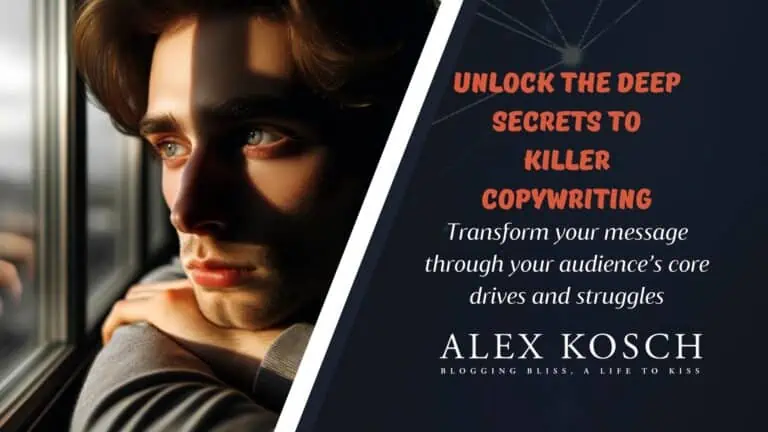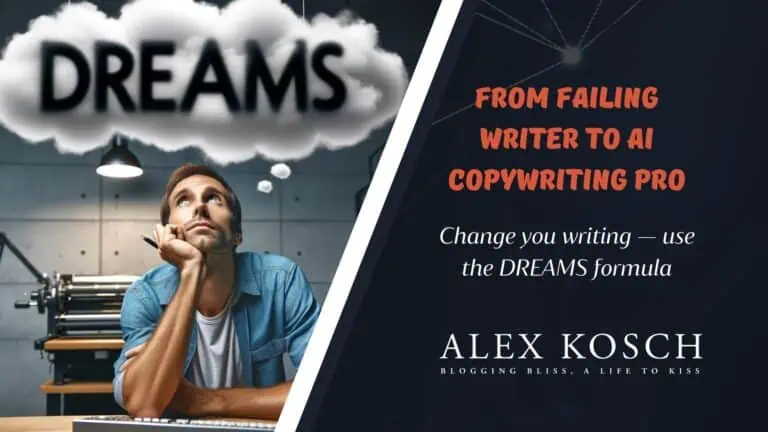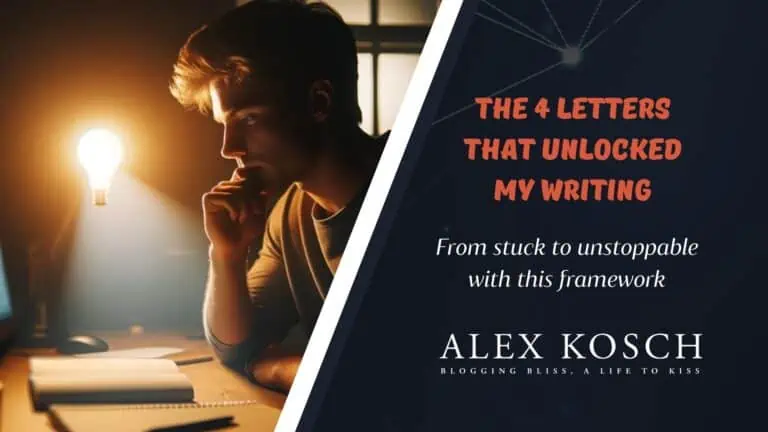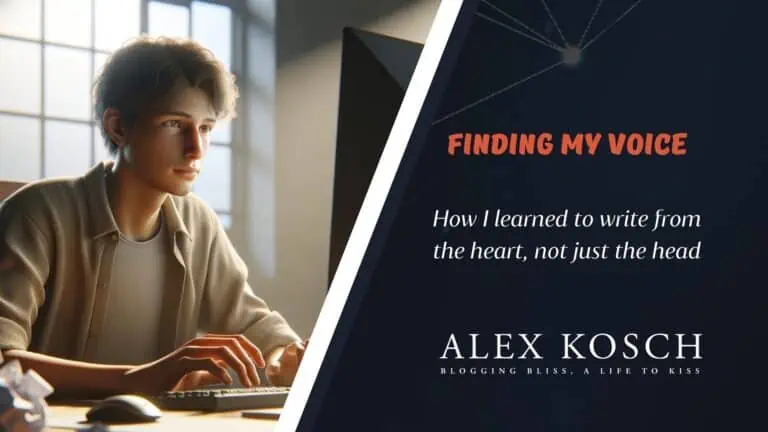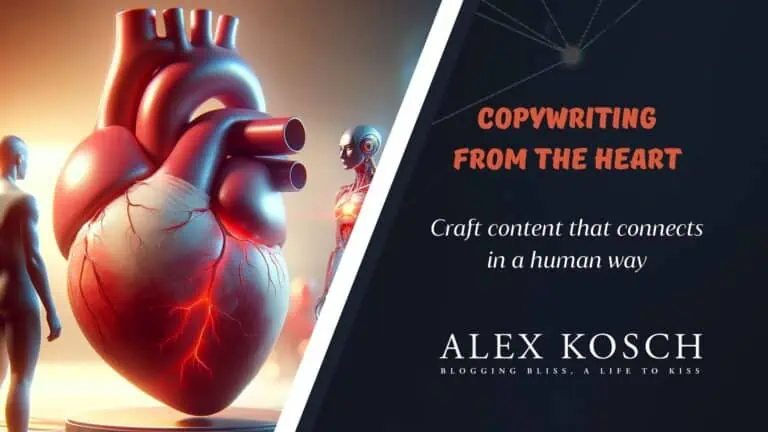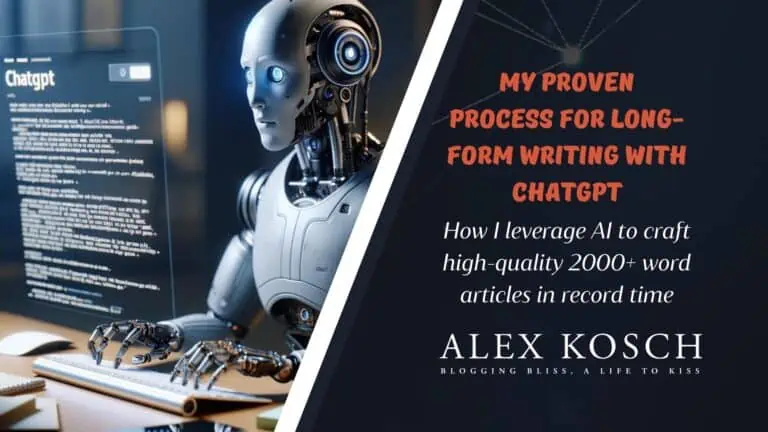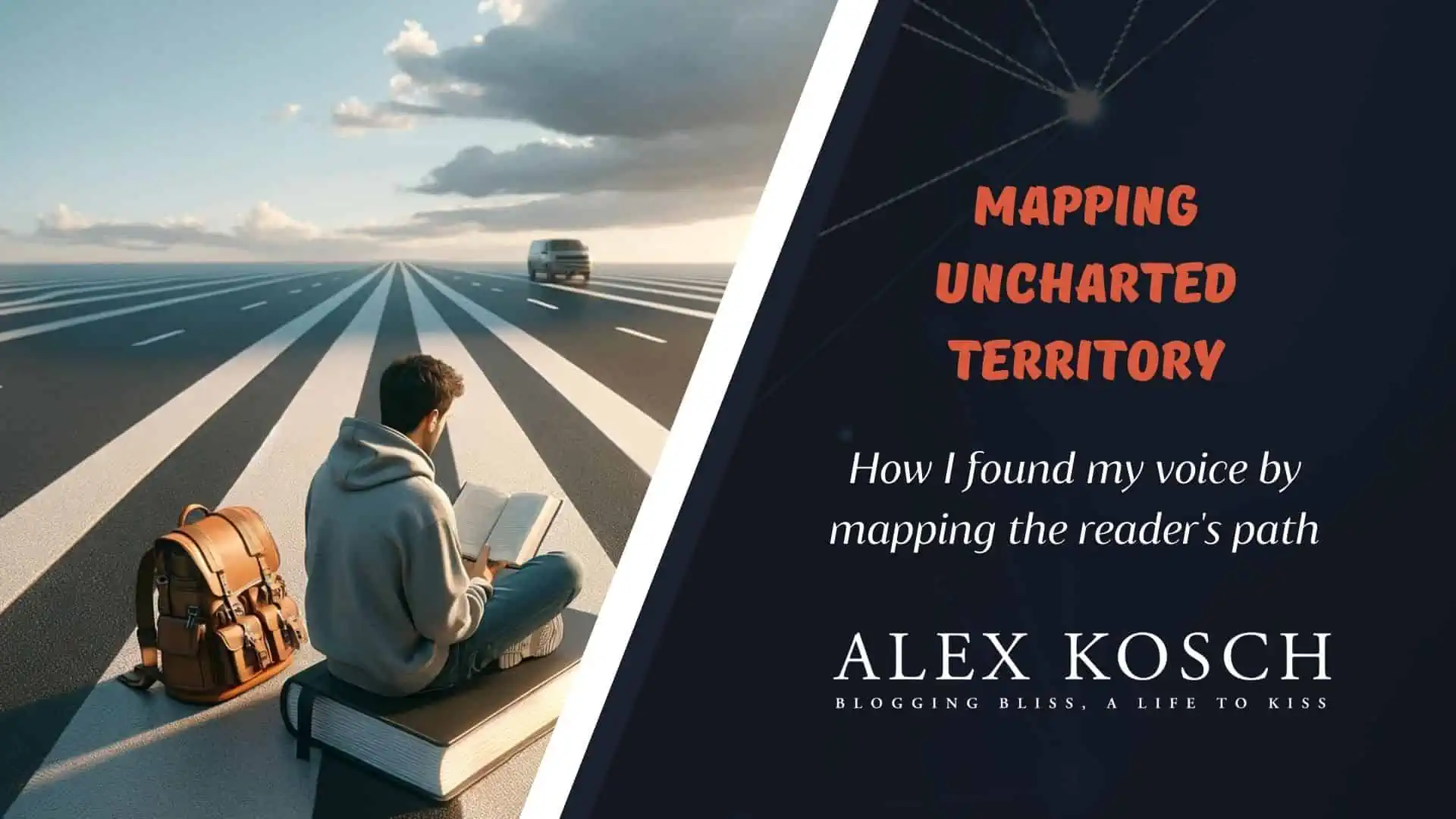
The cursor blinked mockingly at you from a blank page. You knew you needed to write something compelling, but no words came.
Writer’s block again. That old familiar foe, squeezing your creativity like a vise grip. You yearn to craft copy that grips readers, yet grasp at straws trying to formulate the first sentence.
I’ve been in your shoes too many times.
I am Alex Kosch, an AI copywriter.
As a non-native English speaker, writing copy that flows felt impossible for me at first. I could translate text, but generating original ideas was a constant struggle.
That is, until I stumbled upon the fascinating world of AI copywriting.
As a copywriter leveraging tools like Claude from Anthropic, ChatGPT, Agility Writer, Longshot.ai, and many others, crafting copy became enjoyable instead of excruciating. The creative juices started flowing.
And I knew I had to share how AI could help other writers break through blocks and write with confidence.
So, I started this blog focused on AI copywriting strategies anyone can apply. Specifically diving into approaches like the Journey copywriting framework.
With just 3 simple steps, this framework creates a narrative roadmap guiding readers seamlessly through your copy. You’ll learn how to:
- Map the emotional terrain readers must traverse
- Name “dragons” fears inhibiting progress
- Offer guidance to defeat obstacles
The result? Copy that resonates at a core level.
In this article, you’ll discover:
Intrigued? I bet. The Journey can change your copywriting life.
What is the Journey Copywriting Framework?
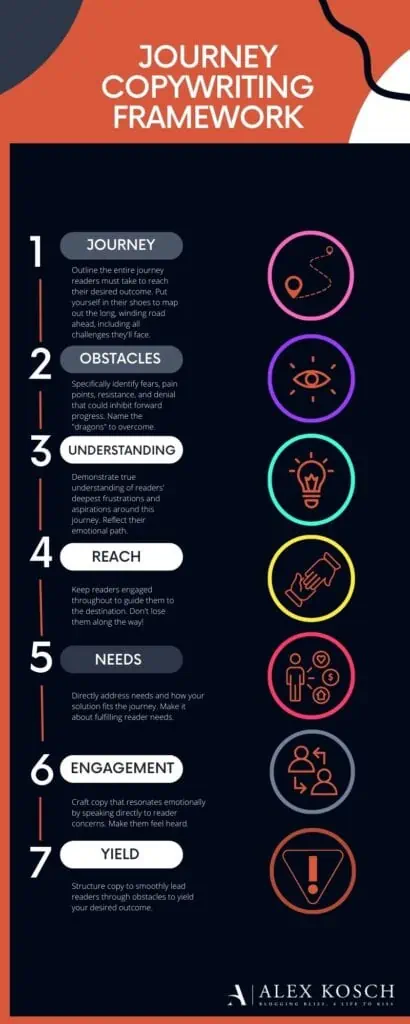
The JOURNEY stands for:
The Journey framework provides a powerful yet simple roadmap to guide readers smoothly through your copy. If you’ve ever felt lost wandering aimlessly through your writing, this framework is for you.
With just three steps, the Journey framework transforms copy from a disjointed mess into an engaging journey crafted specifically for your readers.
Let’s break down exactly how it works:
The Journey Copywriting Framework Deciphered
Let’s look at each key element in detail:
J — Journey: Outline the entire journey readers must take to reach their desired outcome. Put yourself in their shoes to map out the long, winding road ahead, including all challenges they’ll face.
O — Obstacles: Specifically identify fears, pain points, resistance, and denial that could inhibit forward progress. Name the “dragons” to overcome.
U — Understanding: Demonstrate true understanding of readers’ deepest frustrations and aspirations around this journey. Reflect their emotional path.
R — Reach: Keep readers engaged throughout to guide them to the destination. Don’t lose them along the way!
N — Needs: Directly address needs and how your solution fits the journey. Make it about fulfilling reader needs.
E — Engagement: Craft copy that resonates emotionally by speaking directly to reader concerns. Make them feel heard.
Y — Yield: Structure copy to smoothly lead readers through obstacles to yield your desired outcome.
This simple framework transforms aimless copy into an emotional reader journey.
Why “Journey?”
Every reader is on a journey when they arrive at your content. They have a current state of frustration, obstacles, and unmet needs. Your copy must bridge the gap to take them to their desired destination.
The Journey framework accounts for this emotional journey. It addresses fears and pain points holding readers back while guiding them through stuck points towards relief.
Without this map, you risk leaving readers lost — unable to see themselves and their journey reflected in your messaging. The Journey framework solves this by making your copy all about the reader’s journey.
The 3 Simple Steps
Using the Journey framework is easy. Just follow these three steps:
Step 1) Map the entire emotional terrain readers must navigate to reach their destination. Outline frustrations with today and challenges on the horizon.
Step 2) Call out specific “dragons” fears, obstacles, resistance points that could inhibit progress. Directly address these.
Step 3) Offer guidance and tools to defeat dragons and navigate stuck points. Lead readers smoothly through the journey.
With this simple 3-step map, you’ll confidently guide readers through an engaging journey from start to finish.
The Journey framework transforms aimless copy into a reader path crafted specifically for their concerns, frustrations, needs, and desires around this topic. Let’s look at some examples.
Real-World Examples of the Journey Framework
Let’s look at how the Journey framework transforms copy across different niches:
Example 1: Health and Fitness
Niche: Promoting a new diet program
Journey Framework Elements:
Example Copy:
“We know the winding road you’ve been on trying every new fad diet but still feeling discouraged and far from your fitness goals.
The constant yo-yoing leaves you feeling like you’ll never get healthy or have the body you’ve always wanted.
We understand the frustration and despair you feel after putting in so much effort but seeing no lasting results.
Our Journey to Fitness program is different.
We don’t offer quick fixes or empty promises.
Instead, our step-by-step guidance helps you smooth out the bumps on the long path ahead. We start by addressing your fears and obstacles head-on on defeating the doubt, negative self-talk, and other dragons that may be holding you back.
Then we engage and guide you through the twists and turns, providing the tools you need to navigate stuck points.
With our compassionate support, you’ll stay motivated to stick to the lifestyle transformation ahead.
This is not just another fitness fad but a real path to finally achieving your health and fitness dreams.”
Example 2: Software as a Service
Niche: Promoting project management software
Journey Framework Elements:
Example Copy:
“No matter how hard you try, your projects always seem disorganized and chaotic.
You miss deadlines, drop balls, and feel overwhelmed trying to wrangle it all.
We deeply understand the headaches and frustration of disjointed workflows. You just want some structure and clarity.
This is exactly why we built SimpleProjects to guide you through the jungle of scattered projects and tools.
Our intuitive software defeats the overwhelm by keeping all your tasks, people and timelines in one place.
We engage you with visuals like GANTT charts so you can easily track progress.
Features like automated reminders ensure no detail gets lost along the way.
With SimpleProjects, you’ll watch your workflows transform from a tangled mess into a clear, guided path to productivity.
Just follow our simple onboarding journey to tame your workflow chaos once and for all.”
Example 3: Lead Generation
Niche: Promoting email outreach course
Journey Framework Elements:
Example Copy:
“You know how valuable personalized outreach can be, but struggle with how exactly to connect with potential customers without annoying them.
We understand the winding road of trial-and-error, spammy tactics that leave your inbox full of unsubscribe notices. You want to generate leads but don’t know the best approach.
Our proven Attract Leads system guides you through the entire outreach journey.
We walk you through building targeted lists, crafting personalized messages, and structuring effective follow-up.
You’ll learn best practices that engage prospects and defeat fears of being too pushy.
With our step-by-step training, you’ll navigate the stuck points and obstacles that can derail outreach campaigns.
Just follow our compassionate guidance to smoothly guide your journey from introduction to lead generation success.”
Example 4: Career Growth
Niche: Promoting online courses for developers
Journey Framework Elements:
Example Copy:
“You’ve hit a dead end in your developer career and aren’t sure what skills to learn next.
The winding path of choices leaves you paralyzed about what’s right for you.
Will this course actually get you ahead or just waste your time and money?
We understand the frustration of being stuck but aspiring for so much more.
Our online bootcamps map out the terrain ahead to guide your growth journey.
We defeat decision fatigue by engaging you with targeted, hands-on training in high-demand skills.
Follow our step-by-step path to master Python, JavaScript, and more. We provide compassionate support and a community of peers navigating the same journey.
Invest in yourself now to elevate your skills, income, and confidence. You have so much potential let us smoothly guide you to the next level.”
Example 5: Home Improvement
Niche: Promoting DIY home addition guide
Journey Framework Elements:
Example Copy:
“You desperately want more space in your home but don’t know where to start.
Every time you try to research, you end up suffering from paralysis by analysis.
The winding path of permits, contractors, and Blueprints leaves you stressed and overwhelmed. But your family keeps growing, so you ache for a solution.
Our DIY Home Addition Guide understands your frustrations and anxiety.
That’s why we map out the entire journey from demolition to move-in day defeating every obstacle and objection in the way.
With step-by-step instructions, we guide you through choosing an architect, securing financing, hiring contractors and more.
We help you navigate the stuck points so you avoid missteps.
With our easy-to-follow roadmap, you can expand your home with confidence. Just follow our lead to make your home addition dreams a reality.”
Tips for Making the Most of the Journey Framework
Let’s go through each Journey framework element and explore tips to optimize your copy:
Journey: Mapping the Terrain
Best Practices
- Put yourself in the reader’s shoes to outline their emotional path. Imagine you’re the hero in a movie montage showing the winding road.
- Be comprehensive include highs, lows, stuck points, breakthroughs, setbacks, hopes, and frustrations.
- Use vivid and descriptive language that emotionally engages readers by reflecting their journey.
Common Mistakes
- Only focusing on the problem, not the full journey to the solution.
- Being vague or incomplete in outlining the journey.
- Using bland, lifeless language that fails to resonate.
Tips to Optimize
Obstacles: Naming the Dragons
Best Practices
- Be specific in calling out reader fears name the root causes like shame, inadequacy, uncertainty.
- Identify social objections like “My friends will think this is weird.”
- Outline internal obstacles like imposter syndrome and resistance to change.
Common Mistakes
- Staying too high-level with objections like “it costs too much.” Go deeper.
- Focusing only on surface-level objections. Miss the deeper roots.
- Using generic objections that could apply to anyone. Get specific.
Tips to Optimize
Understanding: Reflecting Their Journey
Best Practices
- Use emotional language frustration, confusion, hope, anxiety.
- Reflectaspirations and unmet needs that drive the journey.
- Mirror their mindset and desires, not yours.
Common Mistakes
- Staying too clinical and emotionless.
- Projecting your own perspective rather than reflecting reader’s.
- Focusing too much on features and functions rather than emotions.
Tips to Optimize
Reach: Guiding to the Destination
Best Practices
- Provide a step-by-step framework to follow.
- Use visuals like infographics and screenshots to enhance engagement.
- Sprinkle in social proof like reviews and testimonials.
Common Mistakes
- Neglecting to outline action steps to reach the goal.
- Removing friction and challenges completely rather than guiding through them.
- Forgetting calls to action to move readers to next steps.
Tips to Optimize
Needs: Connecting to Reader Needs
Best Practices
- Focus on fulfilling emotional needs like relief, belonging, achievement.
- craft resonating headlines like “Struggling with X? Here’s how to solve it.”
- Address aspirations and frustrations tied to needs.
Common Mistakes
- Talking about product benefits rather than customer needs.
- Skipping empathy and going straight into features.
- Assuming you already know their needs rather than researching.
Tips to Optimize
Engagement: Making it Emotional
Best Practices
- Use vivid language: Lush, energetic, grounded.
- Share relatable stories and analogies.
- Write like you’re talking to a friend.
Common Mistakes
- Relying too much on stats rather than emotion and narrative.
- Using stiff, formal language that fails to connect.
- Neglecting humor, surprise, delight where appropriate.
Tips to Optimize
Yield: Guiding to Your Outcome
Best Practices
- Clearly define your desired end goal and outline steps to get there.
- Remind readers of progress made and future potential.
- Handle objections and guide through friction points.
Common Mistakes
- Forgetting to state the explicit call to action to achieve the yield.
- Failing to address why they haven’t reached the goal already.
- Ending copy without driving toward a clear next step.
Tips to Optimize
Combining the Journey Framework with Other Frameworks
The Journey framework shines when combined with complementary copywriting frameworks. Let’s look at some top pairings:
Problem Agitate Solve (PAS)
The PAS framework sets up the problem readers face, agitates the pain points, then presents your solution.
PAS Example: “Feeling overwhelmed and exhausted? Do you drag yourself through each day just trying to keep up? Are you sick of endless hustle with no sense of control?”
Journey Combo Example: “We deeply understand the long winding path of fatigue and frustration you’ve been on. Let us guide you through the obstacles and stuck points that have led to burnout. Our program helps defeat the overwhelm, providing clarity and calm to smoothly lead you back to passion and purpose.” (Journey framework added understanding and path guidance)
Sequence PAS before Journey to logically set up the problem, then use Journey to guide readers emotionally through to the solution.
Before After Bridge (BAB)
The BAB framework contrasts the unhappy present state with the improved future after using your solution.
BAB Example: “Stop scowling through tedious data entry. Soon you’ll be smiling through workflow efficiency with our automation platform.”
Journey Combo Example: “We know the long hours you’ve sunk inputting data by hand. Let us guide you on the path to freedom from these tedious tasks. With our platform, you’ll look back on how far you’ve come from data drudgery to smooth automated workflows.” (Journey framework added path guidance)
Use BAB to show the destination, then Journey to outline getting from here to there.
Challenge Solution Benefit (CSB)
CSB identifies a challenge, presents the solution, and describes benefits.
CSB Example: “Struggling with knotted hair? Detangle effortlessly with the Tangle Tamer brush.”
Journey Combo Example: “We understand the long, frustrating journey to finding a brush that makes detangling easy. Let us guide you beyond the obstacles of yanking and snagging. With our Tangle Tamer brush, you’ll look back with joy on the path to pain-free, flowing hair.” (Journey framework added path guidance)
Use CSB to outline the logical details, then Journey to complement with emotional resonance.
AIDA
AIDA stands for Attention, Interest, Desire, Action guiding readers through each phase to take action.
AIDA Example: “This laptop is fast, sleek and powerful. You’ll be tempted by its performance. Give in to desire this machine was made for you.”
Journey Combo Example: “We understand the long road you’ve travelled trying to find the perfect laptop. Allow us to guide you past the obstacles and distractions to arrive at what you’ve been seeking. This sleek machine will not tempt then disappoint like the others. Stay the course and fulfill your quest for perfect performance.” (Journey expanded on path guidance)
AIDA lays out logical steps, while Journey speaks to the emotion behind readers’ decision journey.
Top 10 Tips for Applying the Journey Framework
Here are key tips to maximize results with the Journey framework:
Tip 1: Plot the Journey Arc
- Outline a narrative arc to your journey with a clear beginning, middle, and climax/resolution.
- Hit the major moments from catalyzing event that incited the journey to the apex obstacle and finally achieving the destination. This creates shape and momentum.
Tip 2: Focus on Transformation
- Demonstrate how readers will be emotionally and socially transformed by the end of the journey.
- Show how they’ll grow, gain new abilities, and elevate their status. The journey should change them.
Tip 3: Guide Overcome Obstacles
- The obstacles and resistance points you call out are crucial moments in the journey arc.
- Identify them through customer research then guide readers to overcome through education, social proof, incentives, etc.
Tip 4: Be the Guide
- Position yourself/your brand as the wise guide leading readers through the journey.
- The guide mentors, nurtures and believes in readers as they overcome obstacles together. Build trust.
Tip 5: Texture the Terrain
- Use vivid details, emotional language, analogies, and sensory descriptors to texture the journey.
- This brings the journey to life rather than keeping it abstract. Let readers feel the journey.
Tip 6: Structure your Sections
- Let the journey shape your content sections.
- Each section could tackle a different obstacle, stage, or chapter of the journey. Make progress clear.
Tip 7: Choose a Travel Metaphor
- Pick a specific travel metaphor like climbing a mountain or crossing a desert and stick with it.
- This provides continuity and allows you to vividly describe the journey using the metaphor.
Tip 8: Focus on Progress
- Highlight advancement through each stage of the journey. Celebrate milestones in the arc.
- This builds momentum and keeps readers motivated to continue moving forward.
Tip 9: Provide a Map
- Visually map out the entire journey for enhanced engagement. A picture imprints the journey.
- This map acts as a guide readers can continually refer back to.
Tip 10: Testimonials as Signposts
- Sprinkle relatable stories from others who have successfully completed the journey.
- These act as encouraging signposts, proving others have navigated the path.
By keeping these tips in mind as you apply the Journey framework, you’ll craft resonant copy that emotionally guides readers through each stage from point A to B.
Journey Framework: Template + Prompt + Custom GPT
The Template
Plug your details into this template to easily apply the Journey framework:
Introduction
We understand the long, winding [summarize emotional journey readers have been on]. Let us guide you through the stuck points and obstacles that have caused [summarize pain points and frustrations]. With [your solution], you’ll look back one day on the [make it vivid] journey it took to arrive here.
Section 1: The Path Behind You
[Outlinereaders’ present emotional state, obstacles faced, unmet needs, pain points, etc. Vividly reflect their frustrating journey to this point. Use emotional language.]
Section 2: The Obstacles Ahead
[Name and empathetically validate specific fears, resistance, objections, and “dragons” that may hinder readers’ forward progress. Show you deeply understand their concerns.]
Section 3: Walking the Path Together
[Present your solution and describe how you will guide readers down the path ahead. Highlight key features and steps that will help them overcome obstacles and stuck points. Include incentives, social proof, etc.]
Section 4: Your Transformation Awaits
[Paint an emotional vision of the transformation and growth readers will experience after reaching their destination. Show how completing this journey elevates them. Provide a clear CTA guiding them to take the next step on the path.]
Conclusion
[Summarize and remind readers of the frustrations behind them and accomplishments ahead once they complete the journey you’ve outlined. End with a resonant, inspiring call to action.]
Follow this template, personalizing it with details for your audience and solution, to craft copy that leads readers through an engaging journey.
This is just a template — customize it as you wish according to your needs.
Customizable Prompt for the JOURNEY Copywriting Framework
Here is a customizable prompt to have an AI assistant generate copy using the Journey framework (just copy and paste it):
Topic: [insert your topic here]
Audience: [describe your target audience]
Journey Framework Elements:
J Journey: [What is the winding path and long emotional road your audience has been on leading up to encountering your solution? Describe their present mindset and frustrations.]
O Obstacles: [What fears, pain points, objections or obstacles might inhibit your audience’s forward progress or adoption? Identify resistance.]
U Understanding: [Demonstrate deep empathy for your audience’s frustrations and unmet emotional/social needs related to this topic. Reflect their mindset.]
R Reach: [What specific guidance and steps will engage your audience to guide them through stuck points and obstacles to reach success and transformation?]
N Needs: [Explicitly connect your solution to your audience’s functional and emotional needs identified earlier.]
E Engagement: [What vivid language and emotional connections will best resonate with your audience based on their journey?]
Y Yield: [What is the concrete outcome/transformation you seek by guiding your audience through this journey with your solution?]
COMMAND: Please write the copy for me using the Journey copywriting framework following the format outlined above. Craft the copy to be lively, vivid and emotionally resonate with the target audience. Use conversational language and strong hooks.
JOURNEY: Custom GPT
I make custom GPTs for every copywriting framework I create, so why shoud I miss this one?
If you have ChatGPT Plus subscription, you won’t have to do anything, just access it here.
Now, let’s test it straight away.
I just asked ChatGPT to craft an email copy for my imaginary tool called Koschybot. Here it is:
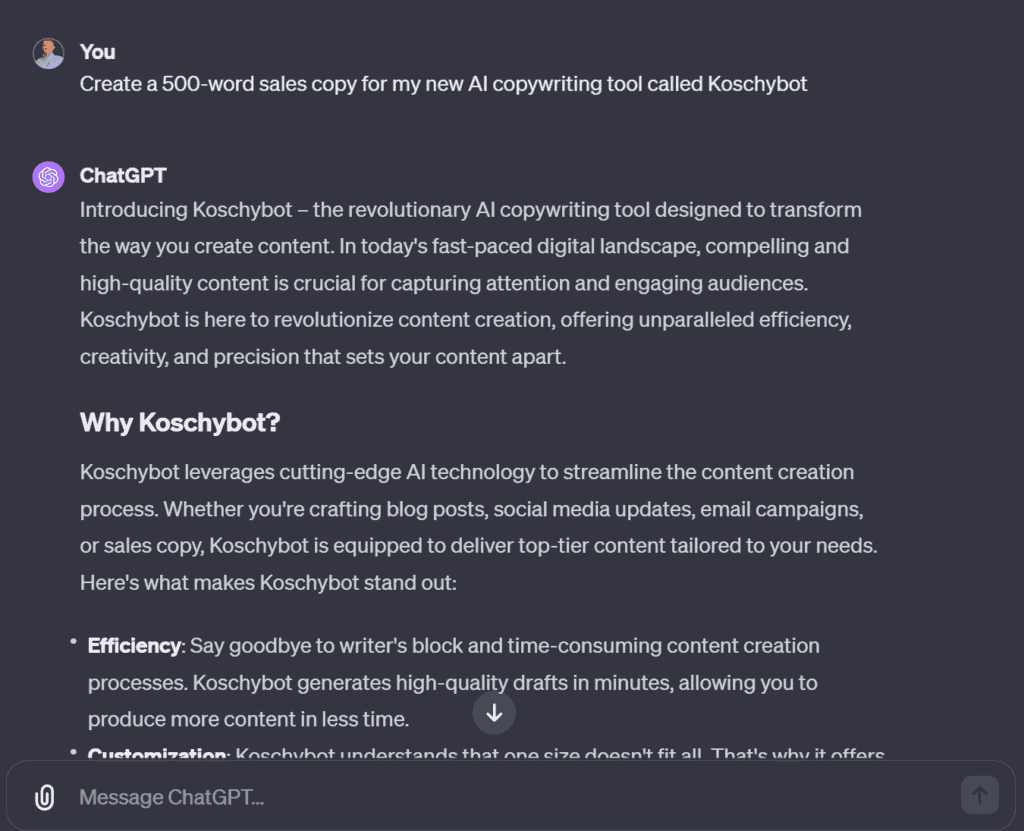
Let’s see what happens if we just paste it into our new custom GPT:

Not a bad copy, I must say.
Of course, you should never use any content generated by any AI tool, including my custom GPT, as is — use this copy as a draft and then create your own.
Let’s check it for originality (I always use Originality.ai, as it is the best AI content detector so far):

It’s even 12% original. Now, let’s process this piece through my AI humanizer, another custom GPT I recently created (I actually spent a ton of time doing this, so I highly recommend to test it out):
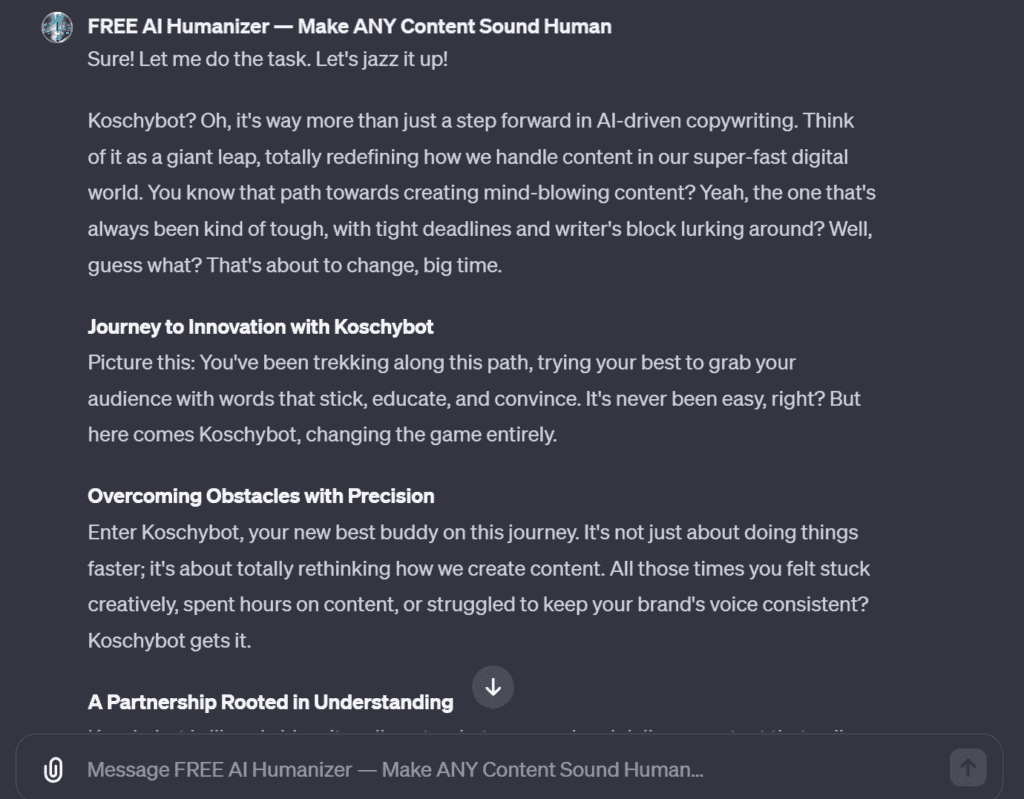
Not perfect, but I’ll repeat — it’s just a draft, not a ready-to-publish copy.
Let’s check this humanized piece through Originality.ai once again:
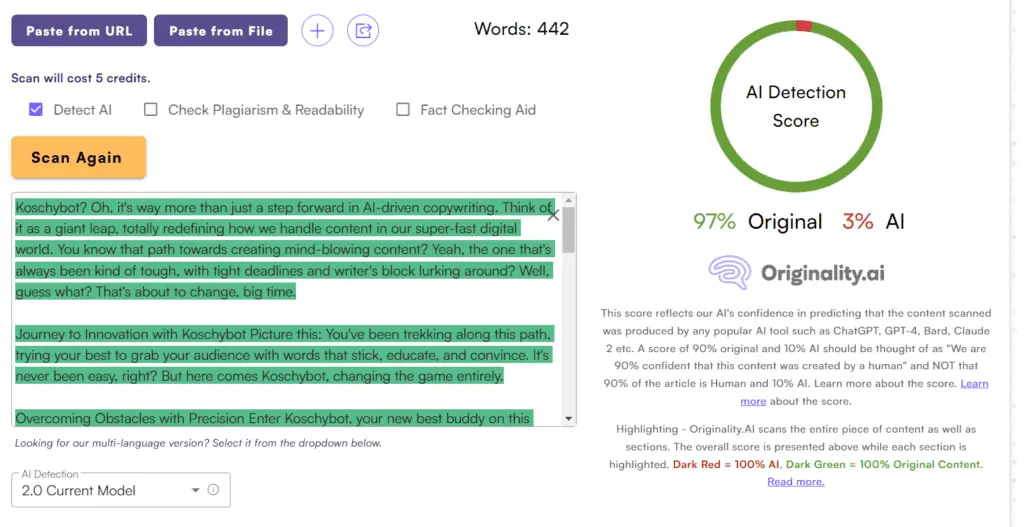
And here’s what we have. I spent a few minutes to 1. write a sales copy for my imaginary AI tool, 2. convert it to a JOURNEY formula, 3. humanize it.
And we ended up with 97% of the original sales copy by moving just a mouse. Yes, we live in interesting times, friends.
Of course, this needs to be taken more seriously. Like I said, JOURNEY is a powerful weapon that you can use to create great copies. Use AI wisely and only as a draft pick.
Journey Framework FAQs
Q: How do I determine the length of the journey?
A: The length depends on the complexity of your solution and customers’ needs. A high-consideration B2B product may require outlining a longer journey vs. a simple B2C offering. Get insight into your customers’ decision process through research.
Q: When should I introduce my product in the journey?
A: Generally you’ll want to outline the journey and obstacles first before introducing your solution as what will guide them through. However, test different placements to determine what resonates best.
Q: How do I balance logic and emotion in the journey?
A: While the Journey framework has an emotional focus, incorporate logical elements like statistics, case studies and proof points too. Experiment to find the right blend for your audience.
Q: Should every section address a different part of the journey?
A: Not necessarily. It’s fine to have some sections focused on the same journey phase if needed to go deeper. Let the narrative arc guide the structure rather than forcing differences.
Q: How do I motivate readers to complete the journey?
A: Highlight the transformation that awaits at the end. Use social proof of others who made it. Offer incentives and emphasize progress made after each obstacle overcome.
Q: How do I determine the major “dragon” obstacles?
A: Use market research and customer interviews to identify their deepest hesitations. Test different obstacles in copy to determine which resonate most to address.
Q: What if my solution only solves part of the journey?
A: Be honest where your solution fits in the arc. Rather than overpromising, be a guide for the phases you can actually help with.
Q: Should I use the Journey framework for all copy?
A: Not necessarily. While powerful for high-consideration products, simplify for low-involvement purchases. Test it against other frameworks to determine best fit.
Q: How can I visualize the journey for readers?
A: Consider tools like journey map diagrams, annotated images of the path, step-by-step infographics, and flow charts to bring the journey to life.
Here is a strong conclusion to summarize the article and motivate readers to apply the Journey framework:
Chart Your Path to Resonant Copy
We’ve covered a lot of ground exploring the Journey copywriting framework. Let’s recap the key points:
- The Journey framework provides a narrative roadmap guiding readers through your copy.
- With just 3 steps outlining the path, naming obstacles, and offering guidance it transforms disjointed copy into an engaging journey.
- Real-world examples across niches demonstrate the framework’s versatility to enhance copy.
- Combining Journey with complementary frameworks like PAS and BAB multiplicatively improves results.
- Tips like choosing a metaphor and visually mapping the path help you execute the framework effectively.
- The fill-in-the-blanks template makes it easy to outline engaging journeys.
The long and winding road of copywriting is smoother when you have a map. With the Journey framework’s simple yet profound guidance, you can confidently chart a course, overcome obstacles, and guide readers seamlessly through transformative journeys.
So don’t leave your audience wandering lost in a dense copywriting forest. Embrace the Journey framework to illuminate the path ahead. Start mapping out engaging journeys that resonate. And let the Journey framework guide your readers and your copy to new heights.
The terrain ahead is filled with potential. Time to embark on your Journey!

About the Author
Meet Alex Kosch, your go-to buddy for all things AI! Join our friendly chats on discovering and mastering AI tools, while we navigate this fascinating tech world with laughter, relatable stories, and genuine insights. Welcome aboard!
KEEP READING, MY FRIEND

